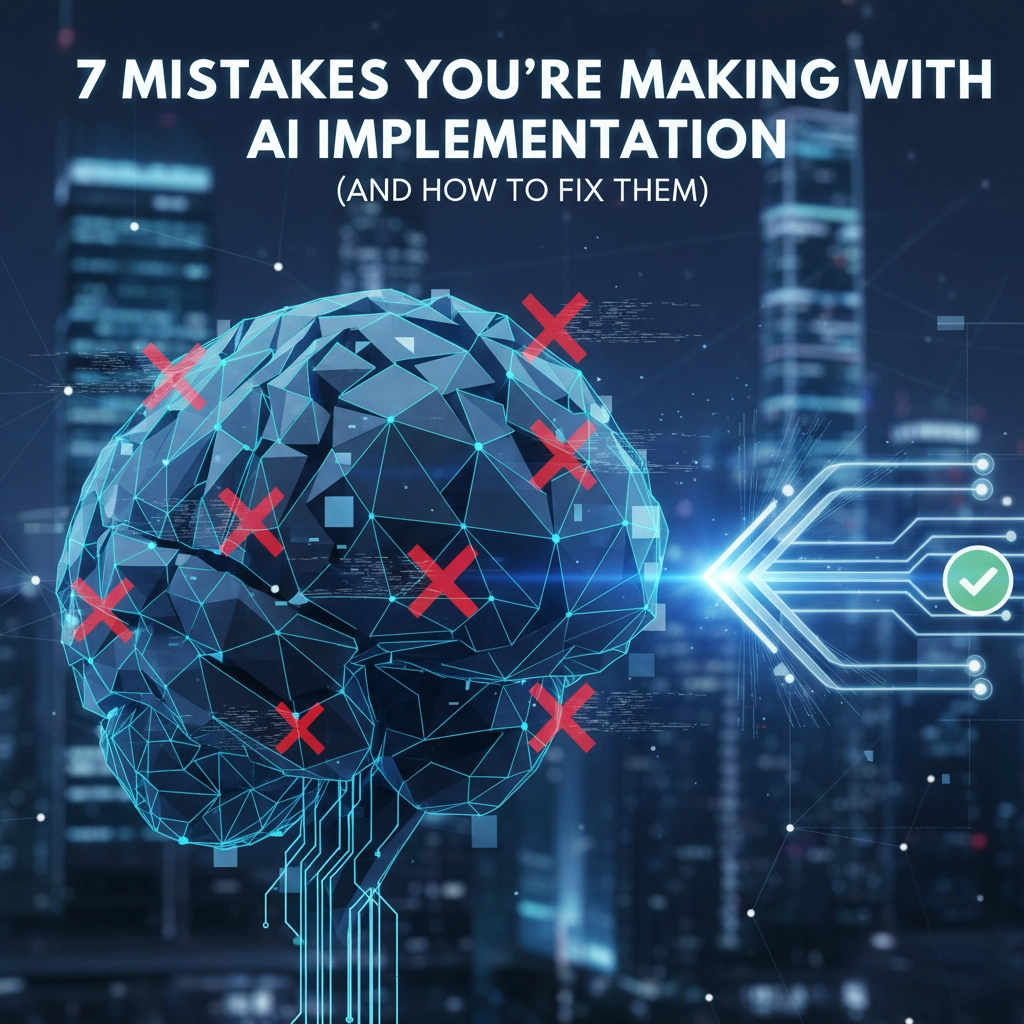Welcome to the Arkstone AI Partners Blog
Our mission is simple: help small businesses like yours use AI to work smarter, save money, and stay ahead of the curve. Whether you’re brand new to AI or just want more practical ways to use it, you’ll find clear, real-world tips and advice here. We’re all about providing value—so our posts focus on things you can actually use, not just trends or hype.
Below, you’ll find a short description of each blog post and a link to read the full article. Click on any title that catches your interest and dive in! If you have questions, let us know—this blog is here to help your business grow.
Blog post- 09/26/2025- AI promises big results—but only if you avoid the most common pitfalls that trip up even seasoned business leaders. In the rush to automate and boost efficiency, it’s easy to make costly mistakes with AI that slow your progress or lead to disappointing returns.
Curious what these mistakes are and, more importantly, how to sidestep them? This post breaks down the seven most common missteps we see and shows you practical ways to fix them—so you can set your business up for real, lasting AI success.

7 AI Mistakes/How to Fix

The statistics are sobering: 80% of AI projects fail to achieve their intended goals. Despite billions invested in artificial intelligence initiatives across industries, most organizations struggle to translate AI's potential into measurable business value. The difference between success and failure often comes down to avoiding critical implementation mistakes that derail even the most promising AI strategies.
At Arkstone AI Partners, we've guided organizations through successful AI transformations. Through our extensive experience, we've identified seven fundamental mistakes that consistently undermine AI implementations: and more importantly, we've developed proven strategies to overcome each one.
Mistake #1: Over-Relying on AI Without Human Oversight
One of the most dangerous pitfalls we encounter is treating AI as a completely autonomous solution. Organizations invest heavily in sophisticated AI systems, then expect them to operate independently without human intervention or oversight.
This approach becomes particularly problematic in customer-facing applications. AI lacks emotional intelligence and contextual understanding that humans naturally possess. When customers encounter complex issues or edge cases, poorly implemented AI creates frustrating loops that damage relationships and brand reputation.
The Strategic Fix:
Implement hybrid AI-human workflows that leverage the strengths of both artificial and human intelligence. Design clear escalation protocols that automatically transition complex queries to human experts when AI reaches its limitations.

Establish continuous monitoring systems where human specialists regularly review AI outputs for accuracy, bias, and appropriateness. This dual-layer approach ensures reliability while maximizing efficiency.
Create feedback mechanisms that allow AI systems to learn from human interventions, continuously improving performance while maintaining necessary oversight.
Mistake #2: Ignoring Data Quality and Infrastructure
AI systems are only as effective as the data they process. Yet many organizations rush into AI implementation without addressing fundamental data quality issues. Inconsistent formats, missing values, duplicated records, and outdated information create a foundation that undermines even the most advanced AI models.
Poor data management doesn't just reduce AI effectiveness: it can produce misleading insights that drive harmful business decisions.
The Strategic Fix:
Prioritize data excellence as the foundation of any AI initiative. Implement comprehensive data standardization processes that ensure consistent formats, complete records, and reliable information across all systems.
Establish rigorous validation protocols that catch corrupted or incomplete data before it enters AI workflows. This includes automated data quality checks and human review processes for critical information.
Develop continuous data maintenance schedules that keep datasets current and relevant. Stale data produces outdated insights that can mislead strategic decisions.
Mistake #3: Implementing AI Without Clear Strategic Objectives
The excitement surrounding AI capabilities often leads organizations to implement solutions before defining specific, measurable objectives. This technology-first approach results in impressive demonstrations that fail to deliver meaningful business value.
Without clear goals, teams struggle to measure success, justify investments, or align AI initiatives with broader business strategy.
The Strategic Fix:
Begin every AI initiative with strategic clarity. Define specific, measurable outcomes that directly support your business objectives. Whether improving customer satisfaction scores, reducing operational costs, or accelerating product development cycles, establish concrete metrics before development begins.
Ensure stakeholder alignment across departments and leadership levels. Everyone involved must understand not just what you're building, but why it matters and how success will be measured.
Treat AI projects like any strategic business initiative: they must solve genuine problems for internal teams or external customers to justify investment and resources.

Mistake #4: Failing to Integrate AI with Existing Workflows
Many organizations implement AI as isolated systems that operate separately from existing processes and tools. This compartmentalized approach severely limits AI's potential impact and often creates additional complexity rather than streamlining operations.
Integration failures prevent AI from accessing necessary data, limit user adoption, and reduce overall organizational efficiency.
The Strategic Fix:
Develop comprehensive integration strategies that embed AI capabilities directly into existing workflows and systems. Map current processes to identify optimal integration points where AI can enhance rather than disrupt established operations.
Focus on building AI capabilities that yield immediate value while positioning your organization for long-term digital transformation. This approach demonstrates early wins that build support for broader AI initiatives.
Create unified data architectures that allow AI systems to access and process information from multiple sources seamlessly, maximizing the value of your data investments.
Mistake #5: Underestimating the Human Element
Technical implementation is only one aspect of successful AI adoption. Organizations often overlook the critical importance of employee training, change management, and addressing legitimate concerns about job security and workflow disruption.
Without proper preparation and support, employees may resist AI adoption, use tools incorrectly, or simply avoid new systems altogether: ultimately undermining entire initiatives.
The Strategic Fix:
Involve employees early in planning and implementation processes. This builds trust, identifies practical concerns, and creates internal champions who support AI adoption.
Provide comprehensive, expert-led training programs that cover practical tool usage, understanding AI limitations, and seamless workflow integration. Focus on helping employees see AI as a tool that enhances their effectiveness rather than threatens their job security.
Communicate transparently about AI's role in augmenting human capabilities rather than replacing workers. Address concerns directly and demonstrate how AI will help employees focus on higher-value, more rewarding activities.

Mistake #6: Chasing Technology Trends Instead of Business Value
The rapid pace of AI advancement creates pressure to implement cutting-edge features that may not align with actual business needs or user requirements. This "shiny object syndrome" leads to impressive demonstrations that fail to drive meaningful outcomes.
Organizations often find themselves with sophisticated AI capabilities that solve problems nobody actually has.
The Strategic Fix:
Maintain laser focus on genuine user needs and business objectives. Resist implementing AI features simply because they're technically impressive or competitively visible.
Start with problems, not solutions. Identify specific challenges your organization or customers face, then determine whether AI provides the most effective solution approach.
Regularly evaluate AI initiatives against core business metrics rather than technical capabilities. Impressive functionality only matters if it drives measurable improvements in customer satisfaction, operational efficiency, or revenue growth.
Mistake #7: Overlooking Ethical Considerations and Bias
Failing to address ethical implications and algorithmic bias can create discriminatory outcomes, legal liability, and significant reputational damage. AI systems can inadvertently learn and perpetuate harmful patterns from biased training data or flawed implementation approaches.
These issues often emerge gradually and can become deeply embedded in systems before being detected, making them expensive and difficult to address retroactively.
The Strategic Fix:
Build ethical safeguards directly into your AI development process. Implement bias detection protocols that continuously monitor outputs for discriminatory patterns or unintended consequences.
Establish diverse review teams that examine AI systems from multiple perspectives, including representatives from affected user groups and communities.
Create regular audit schedules that assess AI systems for fairness, accuracy, and ethical compliance. This ongoing vigilance helps identify and address issues before they impact users or damage your organization's reputation.

Transform Your AI Implementation Strategy
Successfully implementing AI requires recognizing that technology alone isn't enough. You need strategic planning, quality data infrastructure, proper integration, trained personnel, and strong ethical foundations working together as a comprehensive system.
By addressing these seven critical areas proactively, your organization can dramatically improve AI implementation success rates and achieve meaningful business value from AI investments.
The difference between AI success and failure often comes down to having experienced guidance that helps you avoid these common pitfalls while implementing proven strategies tailored to your specific needs and objectives.
Ready to ensure your AI implementation succeeds? Our team at Arkstone AI Partners brings deep expertise in navigating these challenges and delivering measurable results. We work closely with organizations to develop comprehensive AI strategies that drive sustainable growth and competitive advantage.
Schedule a consultation today to discuss how we can help you avoid these critical mistakes and unlock AI's full potential for your business.
